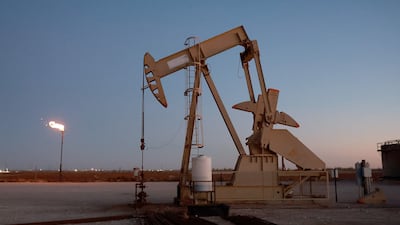Oil prices rose on Friday on expectations of higher demand as China, the world’s largest importer of oil, began easing coronavirus pandemic-related movement restrictions and the EU continued to push for a ban on Russian oil imports as Moscow’s conflict in Ukraine continues.
Crude prices are rallying despite rising recession fears globally amid the coronavirus pandemic, the Russia-Ukraine conflict and the tightening of monetary policy by the US Federal Reserve.
Brent, the benchmark for two thirds of the world's oil, settled 0.46 per cent higher at $112.55 a barrel at the close of the trading session on Friday. West Texas Intermediate, the gauge that tracks US crude, was up 0.35 per cent at $110.28 a barrel.
Both Brent and WTI posted gains for the week as oil markets continued to tighten amid supply concerns and improved demand. Brent gained about 1 per cent this week.
“Despite a wave of risk aversion hitting Wall Street, crude prices still remain supported as oil markets will remain tight for the foreseeable future,” Edward Moya, a senior market analyst at Oanda, said.
The EU, which is heavily dependent on Russia's energy resources, is moving ahead to work out a ban on Russian oil imports. The world’s largest trading bloc plans to ban Russian oil over the next six months and refined fuels by the end of the year.
China, the world’s second-largest economy, is easing pandemic-related restrictions following a decline in the number of infections in the country.
Shanghai, the country’s largest city and commercial hub, began reopening some public transport as the city of 25 million people remains on high alert and continues to take measures to stem the spread of the pandemic. The city is expected to return to normal life from June 1 as authorities consider lifting most restrictions.
“A lot of energy stories could keep crude’s bullish streak intact as the EU is nearing a ban on Russian oil and as the refined products market is poised to get even tighter,” Mr Moya said.
Recession fears are also growing. The global economy is “teetering on the brink of recession” as the war in Ukraine, Covid-19 lockdowns in China and a hawkish US Federal Reserve weigh on activity worldwide, the Institute of International Finance said in a report last week.
In its latest forecast, the IIF estimates global gross domestic product to grow 2.2 per cent this year, with activities slowing to 0.5 per cent in the fourth quarter.
The euro area as well as emerging markets, excluding China, are anticipated to go into a recession by the end of the year.
“At the beginning of the year, no one thought that the S&P 500 was headed to bear market territory, but persistent inflation, another Fed policy mistake, and recession fears have unnerved investors,” Mr Moya said.
“The S&P 500 has lost more than 20 per cent of its value from the January high and it seems that technical selling will only accelerate. The way macro backdrop is unfolding, it seems traders will continue to fade any rallies that emerge until the Fed starts to show signs that they are worried about financial conditions and that they may stop tightening so aggressively.”
This month, the US Federal Reserve raised its benchmark short-term interest rate by half a percentage point, its most aggressive decision since May 2000 as it vies to address the country's worst levels of inflation in 40 years.
Gold, meanwhile, is trading higher as investors continued to increase their investments in safe-haven assets amid heightened geopolitical and economic uncertainty. On Friday, gold was up 0.25 per cent at $1,846 an ounce.
“Gold is comfortably above the $1800 level and seems like it could become attractive again as investors anticipate another round of stock market selling,” Mr Moya said.
Global gold demand surged 34 per cent in the first quarter of 2022, driven by strong exchange-traded fund inflows, according to the World Gold Council.


